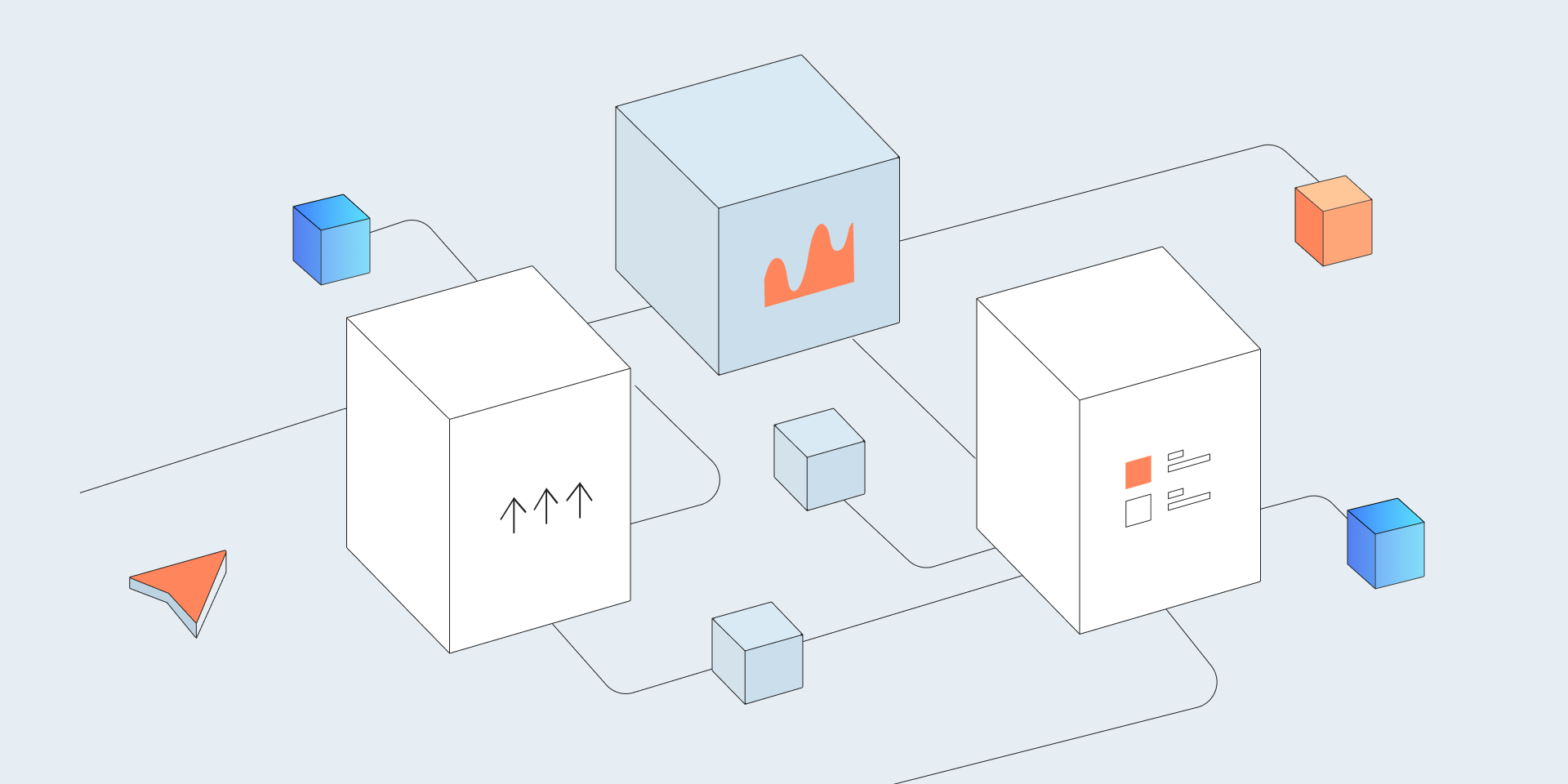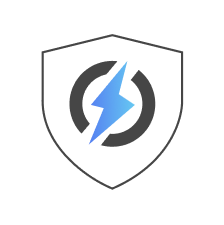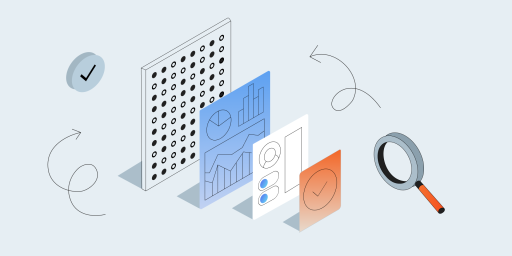It has been more than fifteen years since blockchain technology came into our lives, and at this point, it is safe to say that blockchain is here to stay. With no other technology currently providing the same decentralized, transparent, and secure way to conduct and record transactions, we can expect blockchain to only ingrain itself deeper into our digital lives and become an essential component in even more industries and activities.
Developing blockchain solutions is an idea that appeals to more and more organizations and individuals, which is not surprising, considering how ubiquitous these systems have become. However, blockchain development goes hand in hand with testing. Just as blockchain systems are unique, so is the process of testing blockchain solutions. Find out how exactly testing for blockchain works, how to find a suitable test strategy, and what kind of challenges you can encounter along the way.
Key Takeaways
- Blockchain testing is essential for secure, reliable decentralized applications in the growing Web3 ecosystem.
- Testing must address blockchain’s unique features: decentralization, immutability, consensus, and smart contracts.
- The testing process includes planning, environment setup, functional, security, performance, integration, compliance, and regression testing.
- Automation improves efficiency for smart contract tests, API validation, performance, and regression checks.
- Manual testing is still needed for deep security audits, consensus protocol behavior, and regulatory compliance.
- Key challenges include irreversible contract flaws, complex consensus mechanisms, scalability, and secure key management.
- Specialized tools like Truffle, Hardhat, Ganache, JMeter, and Slither support targeted blockchain testing needs.
- Integrating automated tests into CI/CD pipelines ensures continuous validation and faster issue detection.
- Thorough blockchain testing builds trust, ensures compliance, prevents costly errors, and supports long-term success.
The Critical Role of Blockchain Testing in the Web3 Internet
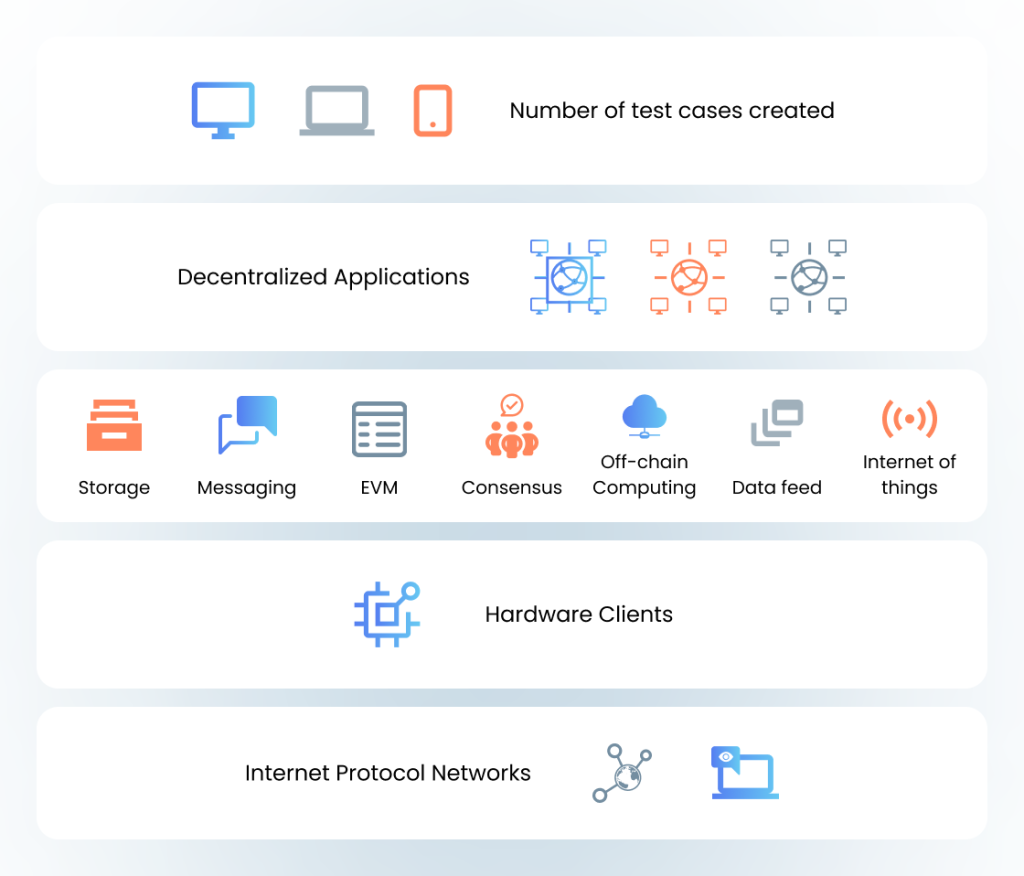
As businesses and industries embrace the decentralized future, Web3 is reshaping the way digital interactions and transactions take place in real time. However, while blockchain technology offers enhanced security, transparency, and automation, it also introduces unique risks that traditional software testing cannot fully address yet. Ensuring the reliability, security, and performance of blockchain-based solutions is an essential component of building user trust and preventing costly failures. This is where blockchain testing plays a vital role.
What is Web3 and How Does Blockchain Fit In?
The Web3 internet is the next phase of digital evolution that revolves around the shift from centralized platforms to decentralized, blockchain-powered ecosystems. Unlike Web2, where corporations control user data and transactions, Web3 leverages distributed ledger technology to enable transparency, security, and user ownership.
Blockchain is the foundation of this decentralized internet that powers several of its most critical components:
- Decentralized applications that operate without intermediaries
- Smart contracts that execute transactions autonomously
- Digital assets like cryptocurrencies and NFTs
While Web3 promises greater control and security for users, it also introduces unique risks that demand rigorous testing.
Why Blockchain Testing is Essential in Web3
The decentralized nature of Web3 means that even minor software flaws can lead to severe consequences. Blockchain testing plays a critical role in addressing challenges such as:
- Security vulnerabilities. Smart contract exploits and cryptographic weaknesses can lead to financial losses and data breaches, something that smart contract testing can prevent.
- Transaction integrity. This helps ensure that blockchain transactions are executed correctly and cannot be manipulated.
- Scalability and performance.Testing network load capacity to prevent slowed-down operations or failures as product adoption grows.
- Interoperability. Validating how different blockchain networks and protocols interact helps make blockchain systems more accessible and compatible with each other.
Additionally, for businesses developing or integrating with Web3, rigorous blockchain testing ensures:
- Stronger market positioning, enhancing credibility and adoption
- Secure and trustworthy solutions, protecting users and assets
- Compliance with evolving regulations, reducing legal risks
- Seamless functionality and user experience, preventing costly failures
Step confidently into the future with our blockchain testing services
What’s Special About Testing Blockchain Technology?
Blockchain testing stands out from traditional software testing due to the fundamental differences in how blockchain-based applications operate. Unlike conventional software, blockchain solutions involve decentralization, cryptographic security, and complex consensus mechanisms — all of which require specialized testing approaches.
Decentralization and Distributed Architecture
Traditional software is typically tested in controlled environments, relying on centralized databases and servers. In contrast, blockchain operates as a distributed network where multiple nodes validate and store transactions. This means testing must account for consensus mechanisms, ensuring that all network participants reach an agreement correctly. It also involves evaluating network resilience to determine how the system behaves when some nodes go offline or when malicious actors attempt to interfere with transactions.
Immutability and Data Integrity
A key difference between blockchain and traditional software is that once recorded, blockchain data cannot be altered. In conventional systems, issues can often be resolved with patches or rollbacks, but in blockchain, transaction errors and smart contract flaws are permanent. This makes pre-deployment testing crucial, as errors cannot be fixed retrospectively. Blockchain testing also requires rigorous validation of transactions to ensure they are processed correctly and only become irreversible when intended.
Smart Contract Testing
Smart contracts are self-executing programs on the blockchain that manage transactions and enforce business logic. Unlike traditional applications, where errors can often be corrected with an update, a single coding flaw in a smart contract can result in severe security breaches or financial losses. Comprehensive testing of blockchain solutions must focus on identifying vulnerabilities such as reentrancy attacks or unauthorized access. Additionally, it involves optimizing gas consumption, especially for networks like Ethereum, where inefficient code can lead to high transaction costs.
Performance and Scalability Challenges
Blockchain networks operate differently from traditional cloud-based applications when it comes to scalability. While conventional systems can be scaled by increasing cloud infrastructure, blockchain transactions are limited by network-wide consensus mechanisms, which can create bottlenecks. Test coverage must include assessing transaction speed and identifying any performance issues that arise under different network loads. It also needs to evaluate how well a blockchain application handles congestion, ensuring stable operation even during periods of high activity.
Regulatory and Compliance Testing
For industries such as finance, healthcare, and supply chain management, regulatory compliance is a major consideration when using blockchain technology. Unlike traditional software, where compliance is often managed through centralized oversight, blockchain requires specialized testing to ensure that data privacy regulations such as GDPR and HIPAA are met without compromising the transparency and immutability of the ledger. Additionally, smart contracts must be audited for legal and security compliance to avoid regulatory risks.
The Most Common Types of Blockchain Testing
Blockchain products operate in highly secure, decentralized environments, making testing a critical step in ensuring reliability, performance, and compliance. Unlike traditional software, blockchain solutions require specialized testing approaches to address unique challenges such as immutability, consensus mechanisms, and smart contract vulnerabilities. Below are the most common types of blockchain testing activities that help businesses mitigate risks and deliver secure, high-performing blockchain applications.
From functionality and performance to security and compliance — we will make your product completely flaw-free
Functional Testing
Functional testing ensures that all blockchain components, including smart contracts, transactions, and consensus mechanisms, work exactly as intended. It helps ensure that blockchain transactions are correctly validated and executed, nodes communicate properly, and smart contracts trigger expected outcomes.
Security Testing
Security is critical in blockchain, as vulnerabilities can lead to hacks and financial losses. This testing identifies weaknesses in smart contracts, private key management, and encryption methods to prevent various attacks on the blockchain platform like reentrancy, double-spending, and unauthorized access.
Performance Testing
Blockchain networks must handle varying transaction loads efficiently. Performance testing and load testing evaluate transaction speed, network latency, and scalability under different conditions and scenarios, ensuring the system can process transactions quickly without bottlenecks or failures.
Smart Contract Testing
Since smart contracts are irreversible once deployed, thorough testing is essential. This includes unit testing, integration testing, and auditing to detect logic errors, security flaws, and inefficiencies in contract execution and computing power usage required to get the job done.
Consensus Mechanism Testing
Different blockchains use different consensus algorithms, such as Proof of Work or Proof of Stake. Testing ensures that these mechanisms function correctly, prevent forks, and maintain network integrity even under malicious attacks or node failures.
Interoperability Testing
Many blockchain applications interact with multiple chains or external systems. Interoperability testing helps ensure seamless communication between different blockchains, APIs, and third-party integrations, preventing transaction failures or data inconsistencies.
Compliance and Regulatory Testing
For industries subject to regulations, blockchain applications must adhere to legal and security standards. Compliance testing verifies data privacy, access controls, and adherence to financial regulations like GDPR, HIPAA, and KYC requirements. This is something best entrusted to testers with specific compliance experience, as many blockchain experts may not have first-hand knowledge of various regulations around the world.
Regression Testing
Blockchain applications frequently undergo updates, whether for performance improvements, security patches, or feature enhancements. Teams perform regression testing to make sure that new changes do not introduce defects or break existing functionality. Since blockchain is unchangeable, any overlooked issue can have long-lasting consequences, making this type of testing crucial before deploying updates to smart contracts, consensus mechanisms, or network protocols.
API Testing
Blockchain applications often rely on APIs to connect with external systems, wallets, and dApps (decentralized applications). End-to-end testing of APIs ensures that these integrations work correctly, securely, and efficiently. It verifies request and response handling, authentication mechanisms, data integrity, and error handling to prevent communication failures that could impact the most critical parts of the blockchain ecosystem or business operations as a whole.
Tools and Technologies Used in Blockchain Testing
Blockchain testing is a complex testing subsection that requires one-of-a-kind testing strategies designed specifically for the blockchain environment. Naturally, this also includes specialized tools to verify security, performance, functionality, and compliance across decentralized systems. Below are key categories of tools used to test various aspects of the blockchain system that can have critical amounts of impact on its performance, security, popularity, and longevity.
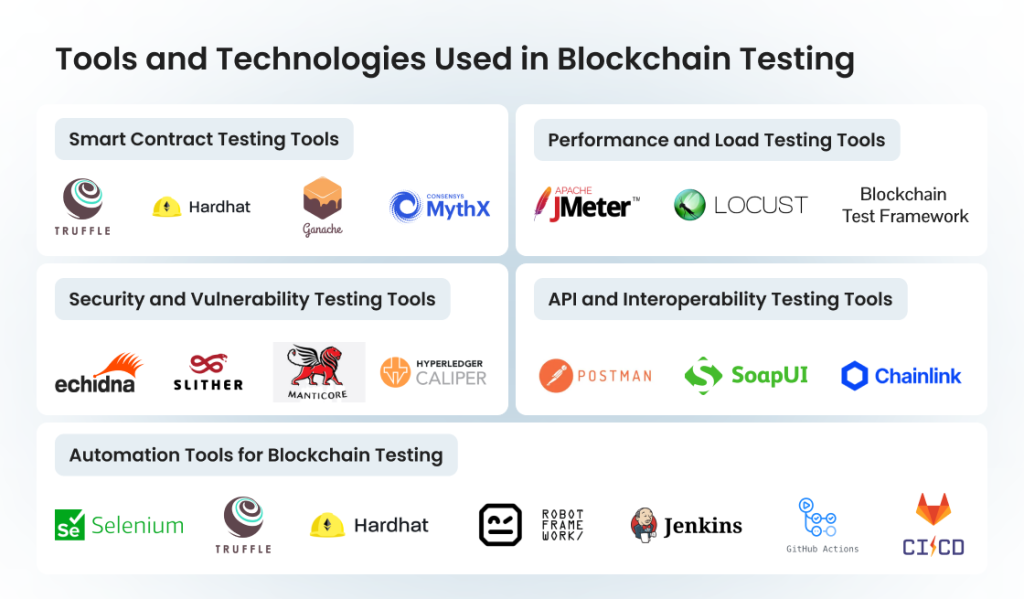
Smart Contract Testing Tools
As we’ve already mentioned, smart contracts are not subject to change once deployed, making pre-release testing crucial. These tools help developers identify vulnerabilities, logic errors, and inefficiencies in computing power usage:
- Truffle. A popular development and testing framework for Ethereum-based smart contracts, offering automated testing with Mocha and Chai.
- Hardhat. A powerful Ethereum development environment that includes built-in testing capabilities for debugging and gas optimization.
- Ganache. A local Ethereum blockchain simulator that enables fast smart contract testing without incurring real transaction costs.
- MythX. A security analysis tool for smart contracts that detects vulnerabilities such as reentrancy attacks and overflow issues.
Security and Vulnerability Testing Tools
Security is a top priority in blockchain applications. These tools help identify weaknesses in encryption, key management, and transaction validation:
- Echidna. A property-based fuzzer that tests Ethereum smart contracts for security vulnerabilities.
- Slither. A static analysis tool for Solidity smart contracts that detects common security flaws and optimizes code.
- Manticore. A symbolic execution tool for analyzing smart contract behavior and identifying exploits.
- Hyperledger Caliper. A blockchain benchmarking tool that evaluates security and performance across different blockchain platforms.
Performance and Load Testing Tools
Blockchain networks must handle varying transaction loads efficiently. These tools help assess network latency, transaction speed, and scalability:
- JMeter. An open-source tool for performance testing blockchain applications by simulating multiple user transactions.
- Locust. A Python-based load testing tool that evaluates blockchain APIs and transaction throughput.
- Blockchain Test Framework. A dedicated performance testing tool for Hyperledger Fabric.
API and Interoperability Testing Tools
Blockchain applications often rely on APIs for external interactions. These tools help validate API performance, security, and compatibility:
- Postman. A widely used API testing tool that verifies blockchain API functionality, request-response handling, and security.
- SoapUI. A tool for functional and security testing of blockchain APIs and web services.
- Chainlink Testing Framework. A tool for testing blockchain oracles and smart contract interactions with external data sources.
Automation Tools for Blockchain Testing
Automation enhances testing efficiency, reduces human errors, and ensures continuous validation of blockchain solutions. These tools help automate blockchain testing:
- Selenium. Used for automating UI testing of blockchain-based applications, especially dApps.
- Truffle & Hardhat Testing Suites. This tool set supports automated testing of smart contracts with built-in scripting and test execution features.
- Robot Framework. A generic automation framework that can be extended for blockchain testing using custom libraries.
- CI/CD Pipelines (Jenkins, GitHub Actions, GitLab CI/CD). These tools enable automating blockchain deployment and testing to ensure consistent performance across iterations.
Meet Your Team of Blockchain Testing Experts
Find out how we can improve your product.
Blockchain Testing Process: 10 Steps to Ensure That Your Blockchain App Is Flawless
Blockchain development is a highly complex process, but the process of delivering an outstanding blockchain solution doesn’t stop there, as it also includes testing and quality assurance. Testing within the blockchain realm goes beyond just testing the security and functionality of blockchain applications, as there are many more things that need to be checked before the solution goes live. A blockchain system needs a precise, structured approach to verify every aspect of its quality. Here are the 10 steps required to test the entire blockchain ecosystem and release the product with confidence.
1. Requirement Analysis and Test Planning
Before testing begins, it’s important to define the blockchain system’s objectives, expected behavior, and testing scope, as well as identify critical components such as smart contracts, consensus mechanisms, APIs, and security requirements. Next, the team will develop a test strategy, outline testing requirements, and choose appropriate tools.
2. Setting Up the Test Environment
At this stage, the key task is to deploy a test blockchain network, such as a private Ethereum testnet or Hyperledger Fabric instance, and configure nodes, wallets, and smart contract environments. Using tools like Ganache or Hardhat, the team can successfully create local blockchain simulations. It’s also crucial to ensure that APIs and integrations are set up to reflect the production environment.
3. Functional Testing
This is where the team will finally start testing by executing test cases prepared during the previous stages. They will need to verify that all blockchain components, including smart contracts, transactions, and consensus mechanisms, perform as expected. Check if transactions are validated correctly, blocks are added to the chain properly, and smart contracts execute the correct logic. Automated testing frameworks like Truffle and Hardhat help streamline this step.
4. Security Testing
Security testing is crucial to verify the reliability of blockchain applications. Among other things, the team will need to assess vulnerabilities that could lead to hacking, double-spending, or unauthorized access, test encryption methods, private key management, and access controls, as well as simulate attack scenarios such as Sybil attacks, reentrancy exploits, and front-running to ensure resilience. To ensure the flaw-free functioning of the blockchain platform, the testers will also need to perform penetration testing by simulating real-world attacks to identify vulnerabilities in smart contracts, network nodes, and authentication mechanisms, ensuring the system can withstand malicious threats.
5. Performance and Load Testing
Thorough testing helps identify bottlenecks that can prevent users from fully enjoying the platform. This stage involves testing the performance and load capabilities of the system. The team will need to evaluate the blockchain’s scalability by measuring transaction throughput, block validation speed, and network latency under varying loads. Using tools like JMeter and Locust, testers can simulate multiple concurrent users and transactions.
6. Smart Contract Testing
Thoroughly testing smart contracts before deployment is a vital part of the testing process in the blockchain field. The testing team will need to conduct unit testing to check individual functions, integration testing to verify interactions, and gas usage analysis to optimize costs. Tools like Truffle and Hardhat provide built-in frameworks for automated smart contract testing.
7. API and Integration Testing
API performance is among the most important components of the blockchain ecosystem because it significantly increases the possibilities both for users and for businesses. The team responsible for testing will need to ensure that the blockchain app interacts seamlessly with external systems, wallets, and third-party services. This involves validating API requests, data exchange formats, and authentication mechanisms using tools like Postman and SoapUI, as well as checking for data consistency between blockchain transactions and off-chain systems.
8. Consensus Mechanism Testing
A consensus mechanism allows blockchain participants to validate transactions and maintain a secure, tamper-proof ledger without a central authority, ensuring trust and decentralization. Therefore, it’s one of the most critical aspects of blockchain solutions to test. Testing here involves validating the blockchain’s consensus algorithm, whether it’s Proof of Work, Proof of Stake, or another model. Testers will also need to check how nodes participate in consensus, confirm that block finalization is secure, and assess resilience against malicious nodes or forks.
9. Compliance and Regulatory Testing
Ensure that blockchain solutions meet industry regulations such as GDPR, HIPAA, and AML/KYC requirements. Verify data privacy policies, identity verification processes, and access controls. Audit transactions for traceability, fraud prevention, and adherence to financial regulations. This is one of the most intricate parts of testing a blockchain application, so it may be a good idea to use blockchain testing services specifically for compliance checks, as compliance blockchain testing becomes more and more challenging with each new rule or regulation.
10. Regression Testing and Final Validation
At this point, it may seem like the testing project is over, but the actual testing process includes one more essential step before the implementation of blockchain software. After updates or fixes, it’s also important to conduct regression testing to ensure new changes don’t break existing functionality, as well as run end-to-end tests across the blockchain network to confirm its stability, security, and performance. Final validation ensures the system is production-ready.
Automated Testing of Blockchain Applications
Automation testing plays a crucial role in blockchain QA by improving efficiency, accuracy, and test coverage. Given the complexity of blockchain ecosystems, automated testing can help streamline repetitive tasks, speed up deployment, and reduce human error. However, test automation cannot be applied to every single aspect of blockchain testing. Some areas still require manual oversight to ensure security, compliance, and resilience against real-world attacks. Here is what you can and cannot automate in blockchain and crypto testing, and how to do it the right way.
What Can Be Automated?
Certain aspects of blockchain testing are well-suited for automation, particularly those that involve repetitive validation processes, structured test cases, and performance assessments. By introducing automation, teams can improve testing efficiency and consistency while freeing up resources for more complex analysis:
- Smart contract testing. Automated frameworks can execute unit and integration tests on smart contracts, ensuring that their logic executes correctly and securely. These tools can also detect common vulnerabilities like reentrancy attacks, integer overflows, and excessive gas consumption, allowing developers to address issues before deployment.
- API and integration testing. Blockchain applications often rely on APIs to interact with wallets, oracles, and off-chain services. Tools like Postman and SoapUI automate API testing by verifying request-response accuracy, error handling, and authentication security. This ensures that blockchain applications communicate reliably with external systems.
- Performance and load testing. Blockchains must be able to handle thousands of transactions per second in high-traffic environments. Specialized tools can automate load testing by simulating network congestion, multiple user interactions, and transaction spikes. This helps assess blockchain scalability and identify bottlenecks that could lead to performance issues.
- Regression testing. Whenever a blockchain system undergoes updates or modifications, regression testing ensures that existing functionality remains intact. Automated testing suites continuously re-run critical test cases, detecting unintended side effects and ensuring seamless upgrades without disrupting core blockchain processes.
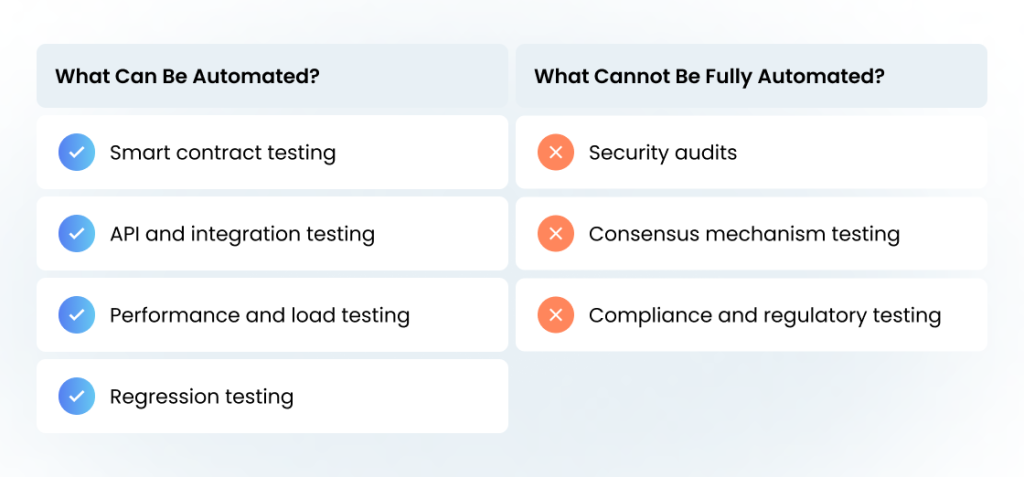
What Cannot Be Fully Automated?
While automation is valuable, some aspects of blockchain testing still require human intervention. These areas involve complex logic, unpredictable behaviors, and compliance considerations that automation alone cannot address:
- Security audits. Automated tools can scan for common security vulnerabilities, but manual code reviews and penetration testing are necessary to uncover sophisticated exploits, such as social engineering attacks or zero-day vulnerabilities. Human security experts assess the blockchain’s resilience against advanced threats.
- Consensus mechanism testing. Blockchain networks rely on consensus protocols like Proof of Work, Proof of Stake, and Byzantine Fault Tolerance to validate transactions. Automated testing tools can simulate network behavior under normal conditions, but manual intervention is required to analyze how nodes react to failures, malicious actors, and fork scenarios.
- Compliance and regulatory testing. Blockchain applications must comply with legal frameworks, industry regulations, and financial reporting standards. While automation can validate encryption and access controls, manual reviews are needed to ensure regulatory adherence based on the specific jurisdiction and industry requirements.
How to Automate Blockchain Testing
To effectively automate blockchain testing, organizations need a structured approach that integrates the right tools, frameworks, and methodologies. Here are the steps the team needs to take to automate the most critical aspects of blockchain testing:
- Define test scenarios. Identify the key blockchain functionalities that need to be automated, such as smart contract execution, transaction validation, and API interactions.
- Choose the right tools. Select automation frameworks like Truffle, Hardhat, and MythX for smart contract testing, Postman and SoapUI for API testing, and JMeter and Locust for performance testing.
- Set up a test blockchain network. Deploy a private testnet using tools like Ganache (for Ethereum-based blockchains) or Hyperledger Fabric Test Environment to simulate real-world conditions.
- Implement CI/CD pipelines. Integrate automated blockchain tests into Jenkins, GitHub Actions, or GitLab CI/CD pipelines to ensure continuous testing and faster issue resolution.
- Analyze test results and iterate. Regularly review test reports, identify failures, and refine test scripts to enhance automation effectiveness.
By following these steps, teams can create a robust and scalable blockchain testing process that minimizes manual effort while ensuring high-quality software releases.
Comprehensive Quality Assurance for a Cryptocurrency Platform
A case study by TestFort
Blockchain Testing Challenges and How to Overcome Them
Due to the complex, decentralized nature of blockchain networks, blockchain testing presents unique challenges. Traditional testing approaches may not fully apply, requiring specialized strategies to ensure blockchain applications are reliable, secure, and scalable. Here are the key challenges and strategies for addressing them effectively.
1. Smart Contract Vulnerabilities
Smart contracts are self-executing and cannot be altered once deployed, meaning any bugs or security flaws cannot be patched easily. Reentrancy attacks, integer overflows, and gas inefficiencies are common security risks.
How to overcome: To address smart contract vulnerabilities, automated static code analysis tools like MythX, Slither, and Oyente should be used to detect security flaws early. Additionally, manual security audits by expert blockchain developers help identify business logic issues. Multi-phase testing, including unit, integration, and fuzz testing, should be conducted before deployment to minimize risks.
2. Complex Consensus Mechanisms
Blockchain networks rely on consensus protocols like Proof of Work, Proof of Stake, and Byzantine Fault Tolerance to validate transactions. Testing how nodes behave under various conditions, which may include network delays, node failures, or malicious attacks, is difficult.
How to overcome: For testing complex consensus mechanisms, private testnets or tools like Ganache and Hyperledger Fabric Test Environment can be used to simulate different network conditions and analyze node behavior. Stress testing in distributed environments helps evaluate how consensus protocols handle high loads, while fault injection testing simulates node failures to assess network resilience.
3. Scalability and Performance Bottlenecks
Blockchain networks must process thousands of transactions per second, but performance issues like high latency, network congestion, and block size limitations can impact efficiency.
How to overcome: Scalability and performance issues can be mitigated by performing load testing with tools like JMeter and Locust to assess how the network handles transaction spikes. Optimizing smart contract execution can reduce computational overhead and lower infrastructure fees.
4. Security Threats and Attack Vectors
Blockchains are prone to 51% attacks, double-spending, Sybil attacks, and private key vulnerabilities that can compromise transaction integrity and network security.
How to overcome: To address security threats and attack vectors, penetration testing should be performed to identify vulnerabilities before deployment. Multi-factor authentication and secure key management practices help protect against unauthorized access. Using formal verification techniques for smart contracts can mathematically prove correctness and security, reducing the risk of exploits.
5. Integration with Legacy Systems and APIs
Many blockchain applications need to interact with traditional enterprise systems, cloud platforms, and external APIs. Ensuring seamless data synchronization and interoperability can be challenging.
How to overcome: For seamless integration with legacy systems and APIs, API testing should be conducted with specialized tools we’ve discussed earlier to ensure reliable data exchange. Middleware solutions can facilitate communication between blockchain networks and traditional enterprise systems. Mock testing can also be used to simulate third-party API responses and validate integration reliability.
6. Regulatory and Compliance Challenges
Blockchain applications must comply with global regulations like GDPR, AML, KYC, and financial reporting standards, which vary by region and industry. Ensuring compliance while maintaining decentralization can be difficult.
How to overcome: Regulatory and compliance challenges can be managed through legal and compliance audits in collaboration with regulatory experts to ensure adherence to jurisdiction-specific laws. Privacy-focused solutions like zero-knowledge proofs help maintain data confidentiality. Automated compliance testing tools can also be used to verify that blockchain applications meet relevant regulatory requirements.
Final Thoughts
Blockchain technology may have been a divisive topic back when it first appeared, but now, years later, it’s clear that it’s much more than just a fad. Given how much trust users put into blockchain transactions, industry experts consider testing to be the only way to create a safer, more secure, and more reliable blockchain ecosystem. Testing your blockchain system to ensure its functionality, performance, usability, and privacy is a crucial aspect of both releasing a new blockchain solution and helping an existing system win over an increasingly sophisticated audience who can tell a trustworthy product from the one that should be avoided. Make sure yours belongs to the first category to confidently advance in the world of blockchain.
Frequently Asked Questions
 Why is blockchain testing different from traditional software testing?
Why is blockchain testing different from traditional software testing?
Blockchain testing must address decentralization, immutability, cryptographic security, and consensus mechanisms — factors not typically present in conventional software, requiring specialized approaches and tools.
 What blockchain testing activities can be automated?
What blockchain testing activities can be automated?
Smart contract unit and integration tests, API and integration testing, performance and load testing, and regression testing are well-suited for automation to improve efficiency and coverage.
 Which parts of blockchain testing still need manual intervention?
Which parts of blockchain testing still need manual intervention?
Manual testing is crucial for security audits, consensus mechanism testing under fault conditions, and regulatory compliance checks, as these require human expertise and contextual judgment.
 What are the main challenges in blockchain testing?
What are the main challenges in blockchain testing?
Key challenges include detecting smart contract vulnerabilities, handling complex consensus protocols, ensuring scalability, securing against attacks, integrating with legacy systems, and navigating regulatory compliance.
 What tools are commonly used in blockchain testing?
What tools are commonly used in blockchain testing?
Popular tools include Truffle, Hardhat, Ganache, MythX for smart contracts; JMeter and Locust for performance testing; Postman and SoapUI for API testing; and Slither and Echidna for security analysis.
Jump to section
Hand over your project to the pros.
Let’s talk about how we can give your project the push it needs to succeed!
